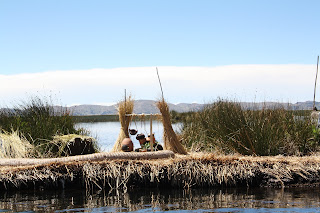From a small port in Puno we took a boat to visit the people who have been making their lives on the floating islands for many generations. I learned a lot about how the people of the islands made their livlihood and managed to survive and keep their traditions for many many years.
 |
| About 14 nuclear families live on the floating islands. Each island must be maintained frequently and every 25 yeras the island must be rebuilt completely. |
 |
| A floating hospital clinic. |
 |
| "Kamisaraki" (greetings in Quechua language) |
 |
| The triangular houses belong to a member of the family called El Presidente who functions as the leader and manages inter-familiar affairs. |
 |
| Walter, El Presidente of the island we came to visit, shows us how the islands are made and maintained. |
 |
| The local women of the village make hadicrafts and tapestries which are sold in the village of Puno to generate revenue for their families. |
 |
| Cooking tools. |
 |
| Estafania and her mother. |
 |
| Titikaka is a mix of two words from Aymara and Quechua which means Puma and Stone, which resemble the shape of the lake when viewed from South to North. |
 |
| Totora MookFish |
 |
| Walter, El Presidente and a boat which took about five months to make. I have one tattooed on my right forearm.. but nobody really cared :) |
 |
| The village of Puno, Peru |








































No comments:
Post a Comment